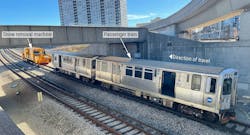NTSB releases preliminary report of CTA Yellow Line accident
The National Transportation Safety Board (NTSB) issued a preliminary report on the Nov. 16, 2023, collision between a Chicago Transit Authority (CTA) Yellow Line train and a snow machine that was on the same track for worker training. The report contains factual information - no analysis - with the investigation continuing.
The facts of the incident have not shifted since NTSB’s final on-site briefing in Chicago. The train, which was traveling at 54 mph in a 55-mph zone, collided with the snow removal machine that had stopped at a red signal. The accident resulted in 16 injuries, no fatalities and an estimated $8.7 million in damages.
The timing of the accident is as follows:
- The passenger train was on a scheduled trip from Dempster Skokie Station to Howard Station.
- The operator was aware that the snow removal machine was operating on the Yellow Line as part of a training exercise but did not know its exact location.
- Shortly before the collision, the southbound snow removal machine stopped about 370 feet north of a red signal indication.
- The passenger train was traveling southbound at about 54 mph when the operator received a stop command from the signal system because the snow removal machine was stopped on the track about 2,150 feet ahead.
- The operator immediately initiated a full-service braking application to stop the train, which NTSB noted is a brake rate of about 4.1 feet per second squared under ideal conditions.
- The operator then saw the snow removal machine and initiated an emergency braking application.
- The train decelerated to about 27 mph before striking the snow removal machine.
NTSB conducted several observations and reviewed data while at the scene of the incident and the NTSB, CTA and Alstom, which acquired Bombardier, the manufacturer of the railcars involved in the accident, will reconvene in Chicago to conduct further tests in December.
The investigation continues
In a press briefing following the release of the preliminary report, NTSB Chair Jennifer Homendy explained footage from inward facing cameras show the CTA operator was “engaged” and “looked to be in full control” of the train.
“At this time, our review of all the locomotive event recorder data, all the data we received and all the testing that we've conducted indicates to us that the operator did not do anything wrong,” said Homendy.
She said the operator indicated he was having trouble stopping the train. The system’s wheel slide protection system, meant to improve braking performance by modulating braking effort, did engage during brake application. Homendy said NTSB is performing laboratory analysis of the organic material found on top of the running rails of the incident area to determine if it had any impact on the accident and further testing will try to repeat the wheel slippage experienced during the accident.
NTSB will also continue its investigation into the design and configuration of the CTA signal system, as well as the design and braking performance of the railcars involved in the accident. NTSB previously determined CTA’s signal system at the accident location had a configured stopping distance of 1,780 feet or less. A system built today would require the same type of rail operation to have a stopping distance of 2,745 feet or less.
Homendy explained operations change and there are many factors that go into stopping distance; NTSB will be looking into if the system was reconfigured over time.
Yellow Line service remains suspended
Following release of the preliminary report, CTA issued a statement acknowledging its publication and says it appreciates NTSB’s ongoing review of the incident.
“We continue to work closely with the NTSB on its ongoing investigation of the incident. From the beginning, the CTA has been fully committed to assisting the NTSB investigation in any way possible. We continue to provide the agency full access to equipment, facilities, records, personnel and any other information it requests,” the transit agency said. “The CTA is currently engaged in an extremely thorough review of all aspects of the Yellow Line mentioned in the NTSB preliminary report, from signals to tracks to equipment, as well as testing trains to ensure safe operation. These activities require time to perform and once this review is complete, CTA will determine a plan to reopen. Safety continues to be our No. 1 consideration.”
When asked during the press briefing if the line was safe, Homendy did not specifically say yes but did note passenger rail travel is among the safest modes of transportation available and explained the onus of safe operations of the Yellow Line falls to CTA.
She did share steps CTA has taken since the accident, which include reducing the maximum allowable speed on the Yellow Line from 55 mph to 35 mph, reducing maximum allowable speed at the incident area to 25 mph, cleaning running rails to remove debris and modifying its track maintenance program to ensure this work continues. Homendy said CTA also reports to NTSB it has instituted additional supervision and has launched a communication campaign with employees about the changes.
Homendy said CTA has not indicated if any design changes to the system have taken place.
The NTSB preliminary report, “Chicago Transit Authority Yellow Line Train Collision with Snow Removal Machine,” is available at NTSB’s website.
About the Author

Mischa Wanek-Libman
Group Editorial Director
Mischa Wanek-Libman is director of communications with Transdev North America. She has more than 20 years of experience working in the transportation industry covering construction projects, engineering challenges, transit and rail operations and best practices.
Wanek-Libman has held top editorial positions at freight rail and public transportation business-to-business publications including as editor-in-chief and editorial director of Mass Transit from 2018-2024. She has been recognized for editorial excellence through her individual work, as well as for collaborative content.
She is an active member of the American Public Transportation Association's Marketing and Communications Committee and served 14 years as a Board Observer on the National Railroad Construction and Maintenance Association (NRC) Board of Directors.
She is a graduate of Drake University in Des Moines, Iowa, where she earned a Bachelor of Arts degree in Journalism and Mass Communication.
